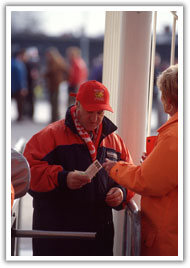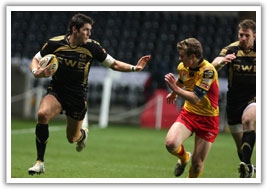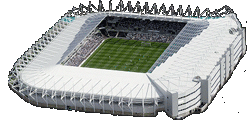Mynd i mewn i’r stadiwm a gadael
Cyn y gêm
Gweithgaredd 1
Crynhowch yr amrywiaeth o weithgareddau sy’n digwydd yn y stadiwm yn yr awr cyn i’r gêm ddechrau.
Polisïau mynediad
Gall rheolwyr meysydd chwaraeon benderfynu ar nifer o bolisïau ynghylch gwerthu tocynnau a mynediad i’r maes. Gall y polisïau sy’n cael eu mabwysiadu gan reolwyr y maes gael effaith uniongyrchol ar gyfraddau mynediad a’r rheolaeth ar ardaloedd mynediad a lle gwylwyr yn gyffredinol.
Specific points to consider include:
a. Cash sales
To ensure a steady flow of spectators into the ground when entry is by cash, the admission price should ideally be set at a
round figure which avoids the need for large amounts of small change to be handled.
The turnstile operators should also be provided with adequate amounts of change, topped up if necessary by staff assisting the operators.
b. Ticket or entry card only sales
The advantages of confining entry to tickets or entry cards are that the rate of admission should be higher than for cash
sales, and the system allows different categories of spectator (for example, parent and child) to purchase adjacent seats and enter the ground together.
If tickets or entry cards are sold on the day of the event, wherever possible, separate sales outlets should be provided. These
outlets should be clearly signposted, and positioned so that queues do not conflict with queues for turnstiles or other entry points.
c. Reserved (or numbered) seat ticket or entry card sales
Selling tickets or entry cards for specific numbered seats has the advantage that the seats are more likely to be sold in blocks.
This policy helps to avoid random gaps and ensures that in the key period preceding the start of the event there will be less need for stewards to have
to direct latecomers to the remaining seats, or move spectators who have already settled.
Another advantage of this policy is that it makes it possible for management to sell the total seated capacity of the ground, or section of the ground.
d. Unreserved seat sales
Selling unreserved seats, whether by cash or ticket, has the advantage of being easier to administer. However, spectators are prone
to occupy seats in a random pattern, and, as stated above, it can be hard to fill unoccupied seats in the key period before the start of the event.
For this reason, when seats are sold unreserved, a reduction in the number of seats made available for sale is likely to be necessary.
This reduction may be in the region of 5–10 per cent of the total capacity of the section, according to local circumstances.
e. No ticket or cash entry on the event day
If all tickets have sold out in advance, or if the management decides not to sell tickets or allow cash entry on the day of the
event, every effort should be made to publicise this fact in the local press and media. In addition, signs advising the public of
the situation should be placed along all approaches to the ground, in order to avoid an unnecessary
build-up of crowds outside the ground and its entrances.
f. Ticket design
The design of tickets can have a direct effect on the rate of admission. For example, clear, easy-to-read information will speed
the ability of the turnstile or entry-point operator to process the ticket. Similarly, if anti-counterfeiting features are incorporated,
simple procedures should be in place for the operator to check each ticket’s validity.
g. Electronic entry card design
Electronic entry cards, similar to credit cards, are becoming increasingly common and replacing paper tickets.
In the case of card systems, where no operator is immediately present, it is essential that the card user has clear
instructions both with the card and on the card reader at the point of entry on how to:
- present the card for validation
- seek assistance should the reader fail to recognise the card as valid and therefore prevent entry
Gweithgaredd 2
Crynhowch y materion ynglŷn â gwahanol bolisïau mynediad a gwerthu tocynnau, gan nodi manteision ac anfanteision systemau gwahanol.

Mynd i mewn i’r stadiwm (Ingress)
Gan ddefnyddio systemau cyfrif electronig modern, mae’n bosibl gwybod faint yn union o bobl sydd yn y stadiwm ar unrhyw adeg cyn gêm.
Mae angen i wylwyr sy’n mynd i mewn i bob rhan o’r maes, gan gynnwys ardaloedd i bobl bwysig iawn ac ardaloedd hamddena, gael eu cyfrif wrth iddyn nhw fynd i mewn, ac mae angen rheoli eu nifer er mwyn sicrhau na fydd gormod o bobl yno.
Mae hyn yn wir hyd yn oed os ydy mynediad i’r gweithgaredd drwy docyn neu gerdyn mynediad electronig yn unig.
Each section of spectator accommodation should be served by metered turnstiles or other means of counting, in order to keep a tally of the number of spectators admitted to that section.
This is important for two reasons:
- Management will need to assess how long it will take for the remaining people outside the ground (if any) to be admitted before the start of the event. If the number queuing is greater than can be admitted at the prevailing rate of admission, wherever possible extra turnstiles should be opened to cope with the demand. If this is not possible, consideration should be given as to whether or not the start of the event should be delayed.
- When entry is other than by ticket or entry card for reserved seats, management will need to know when the section is near capacity so that:
- the turnstiles can be closed before the capacity is exceeded
- people queuing or approaching the turnstiles can be warned and, where appropriate, re-directed to entrances serving other sections of the ground
The entry capacity is the number of people who can pass through all the turnstiles or entry points serving either the whole ground or one section, within a period of one hour.
The rate at which people can pass through each turnstile or entry point will vary according to a number of local factors.
The main factors affecting the rate of entry are:
- the number and dispersal of turnstiles/entry points
- the adequacy of directional information and communications
- the means of entry; for example, cash payment, ticket, entry card or voucher
- the division of entry categories; for example, adults, concessions or groups
- the design and condition of turnstiles/entry points
- the capabilities of turnstile operators
- the efficiency of the system and the ability of the spectator to understand the recognition system where electronic entry cards are in use
the level of searching required, particularly at times of high security alert. The use of metal detectors, bag and body searching may significantly reduce the rate of passage
Gweithgaredd 3
Gwerthuswch bwysigrwydd cofnodi’r union nifer o wylwyr mewn stadiwm ac ar ba gyfradd maen nhw’n mynd i mewn.


Mynd allan o’r stadiwm (Egress)
Cydnabyddir yn gyffredinol bod adeg gadael y stadiwm yn gyfnod o risg mawr i ddiogelwch y dorf. Felly, mae’n bwysig darparu systemau mynd allan sy’n gallu darparu ar gyfer pobl yn symud allan yn ddiogel o fewn cyfnod derbyniol ac osgoi tagfeydd a straen seicolegol. Gall systemau mynd allan gynnwys tramwyfeydd, grisiau, llwybrau, rampiau a dulliau eraill o symud.
Rhaid i reolwyr stadiwm sicrhau bod ffyrdd mynd allan yn cael eu cynllunio a’u rheoli’n ddiogel, er mwyn sicrhau ar gyfer gwylwyr symudiad esmwyth dirwystr drwy system mynd allan nes iddyn nhw gyrraedd ffin y maes neu, mewn argyfwng, le o ddiogelwch.
In order to achieve this, management should ensure that:
- there are sufficient numbers of exits in suitable locations
- all parts of exit routes are of adequate width and height
- people do not have to travel excessive distances in order to exit from the spectator accommodation
- provision is made for the control of spectators entering an exit system
- all exits are identifiable in both normal and emergency conditions
The egress time is the total time in which all spectators can, in normal conditions, leave an area of viewing accommodation and enter into a free flowing exit system. It does not include the time taken to negotiate the entire exit route. The normal maximum egress time for sports grounds is eight minutes.
If for any reason – for example, there are not enough exits – spectators cannot exit within eight minutes, a reduction of the final capacity may be required.
The limit of eight minutes has been set as a result of research and experience, which suggests that within this period spectators are less likely to become agitated or experience frustration or stress provided they enter an exit system at an acceptable rate, or are familiar with the sports ground and/or can identify their point of exit.
In certain circumstances it may be appropriate to apply a shorter egress time than eight minutes; for example, if the design or management of the viewing accommodation is such that regular observation shows that spectators become agitated or experience frustration or stress in periods of less than eight minutes.
Gweithgaredd 4
Eglurwch y cysyniad ‘amser mynd allan’ (egress time) a pham mai’r cyfnod sy’n dilyn diwedd y gêm yw’r cyfnod pan fydd y risgiau mwyaf i ddiogelwch y dorf.
